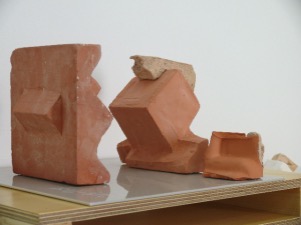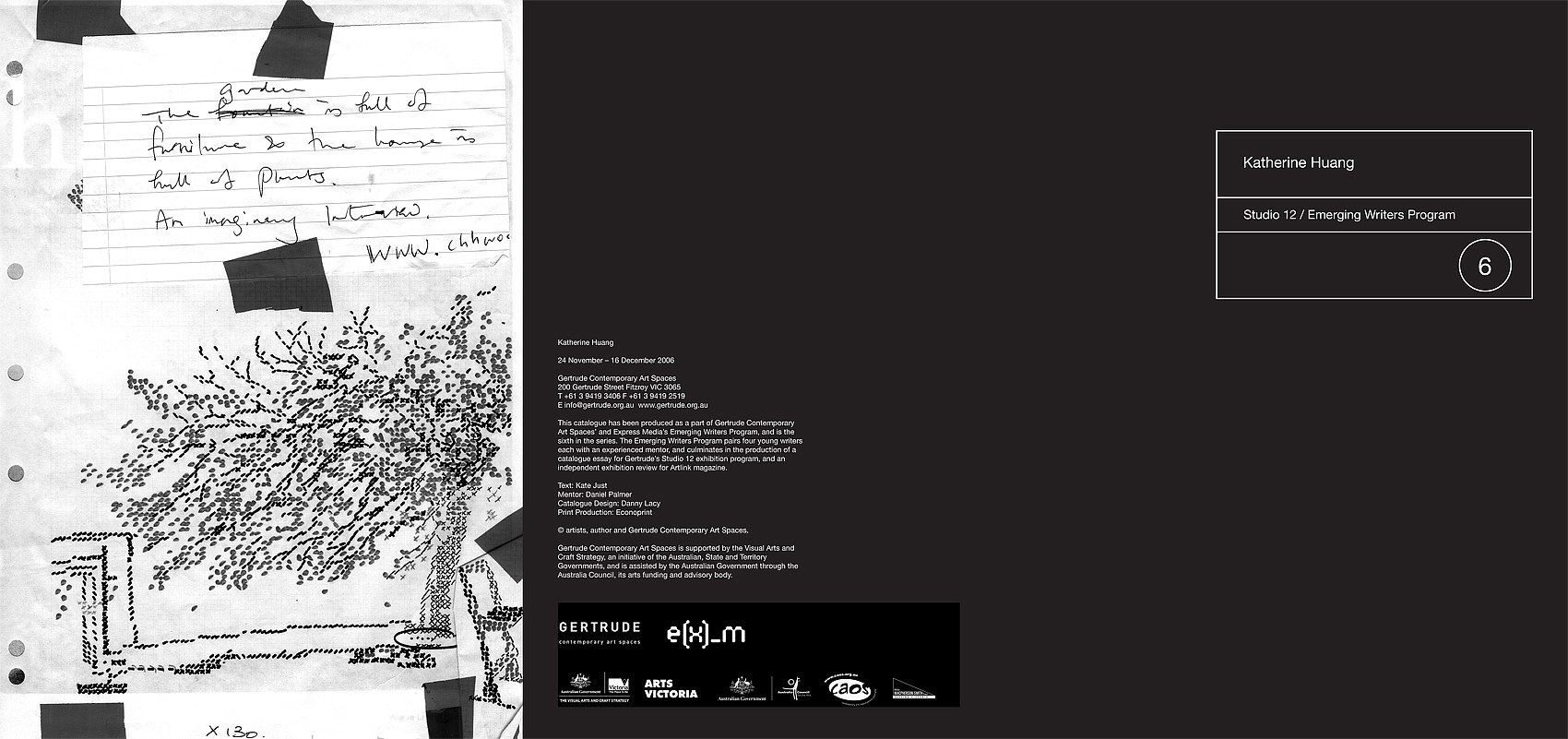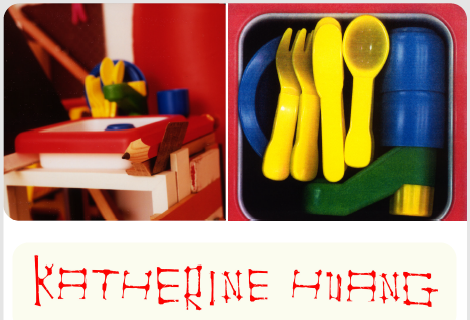Clare Marshall Writing and Editing Portfolio
http://crmarshall.wordpress.com/2013/03/06/art-review-katherine-huang/
ART REVIEW: KATHERINE HUANG
Published April 2004
‘To name an object is to do away with the three-quarters of the enjoyment of the poem that comes from the pleasure of diving little by little; to suggest it, there is to dream.’
Stéphane Mallarmé
Viewing Katherine Huang’s work, a connection can be made between her multi-layered assemblages and the structure or formation of language. The intricate arrangements of personal and found objects on surfaces of plastic, wood and metal suggest clusters of words or phrases, the meaning of which remain lodged on the tip of the tongue. The idea is not to tell a single story but to suggest many. Colours and forms – like words – can have multiple meanings, which shift according to context or emphasis. Huang’s installations are not codes to be cracked, rather visual explorations of the muddled process of perception.
Huang is an artist who draws inspiration directly – and physically – from her surroundings, be they the cluttered laneways of inner-city Melbourne, the makeshift road-side structures of her native Taipei, or the rough-hewn natural beauty of Fraser Island. As well as collecting objects on her way to and from her studio she absorbs the character of the place, the activities that make it hum. As a result, viewing Huang’s installations can be a little like accompanying her on her travels. While appreciating the sweep and scale of the overall view, the eye is drawn to the minutiae dotting the corners – much as Huang’s is while traversing the city streets.
Perspective is a major component of Huang’s work. Usually the viewer assumes – simultaneously – the role of Gulliver in Lilliput and a child at play in her cubby house. We are invited to crouch down and lean in closer to observe details that could easily be overlooked. The cubby house aesthetic lends a playful element to Huang’s work. Think of a child ‘driving’ her shoes; the sneaker becomes a shiny, white convertible, the brown school loafer a battered rust-trap. In the realm of play, objects are not restricted to their usual function – meaning is fluid and associative. For example, in Huang’s Chair with corn yellow sock plus one cloud (2001) a piece of crumpled origami paper, some shells and a plastic palm tree atop a perspex chair are used to represent an island.
Rather than acting as a fixed code or index, Huang’s assembled objects occupy the slippery space between form and function, word and meaning. Materials such as the fluorescent orange mesh used on building sites or a child’s plastic picnic set seem strangely appealing, even exotic, when taken out of their everyday context. They are there to be admired on a purely aesthetic level, as the fruits of an urban archaeological dig. The connection between each item is never made clear, perhaps does not even exist. Instead, viewers are obliged to flesh out the diaphanous narrative with their own memories, experiences and assumptions.
Huang describes her work conversely as ‘messy fairy installations’ and ‘contemporary picture poetry’ – the former expressing the whimsical and seemingly haphazard nature of her assemblages, the latter acknowledging the careful planning and arrangement behind them. Each installation is approached as a 3-D drawing, so that the piece as a whole is equally striking as the myriad stories that unfold within and around its spaces. Above all, objects are presented to us as being precious, in spite – or perhaps because – of their ordinariness. Huang’s assemblages are tributes to everyday items and instances, records of the common, personal and imagined experiences comprising our day-to-day existence.
http://danrule.wordpress.com/2009/08/22/around-the-galleries-august-2009-3/
Around the galleries – August 2009
August 22, 2009
Published: The Age, A2, August 15, 2009.
Around the galleries Dan Rule

WHERE Neon Parc, Level 1, 53 Bourke Street, city, 9663 0911, neonparc.com.au
This unassuming little show from Melbourne’s Katherine Huang resonates with both an architectural and geographical nuance. Her compact, modular sculptural arrangements – comprising plaster and terracotta casts, plastics and discreet, found objects – feel like the relics of a lost city. But this new body of work, created following travels in the Middle East, isn’t part of some modelling project. The architectural languages that permeate Huang’s work are far too inconspicuous to be literal. A potential roofline occupies the mind for a second, before being subsumed by a less definable angularity; a city square becomes a more abstract gesture of space. The fact that her primary terracotta works were cast from the polystyrene packaging of an Apple Macbook offers another intriguing divergence. Wed to Sat noon–6pm, until August 29.

Published: The Age, August 13, 2011
Baby mess
In the seductive atmosphere of the city after dark, the sight of a utilities maintenance crew working into the night provokes curiosity. They perform under theatrical floodlight, on a stage encircled by a temporary barrier that prohibits access, but invites observation. A space is occupied; provisional structures are erected. Katherine Huang’s intricate assemblages reference these ephemeral events and the materials they generate. Building sites, advertising fixtures, lights, traffic – they are the residue of a collective urban activity that remind us a city’s architecture and thoroughfares remain inert until activated and defined by the movements of its inhabitants and the traces they leave.
Huang works from a small corner in a shared studio situated in a particularly active area of Melbourne’s CBD, and many of her objects are sourced while en route to and from the studio. This immediate environment – a colourful concentration of narrow streets and energetic commerce – offers some clues to the associative relationships in Huang’s work. Constructed from encountered and invented objects, her arrangements resonate as structural metaphors of the ‘envisaged’ city. One negotiates these interconnected forms like an architectural site or model – placement generates ‘place’ – and the works’ scale allows multiple perspectives so that plan, elevation, interior and exterior are suggested simultaneously.
Recent works unfold as one physically approaches them and evoke a sense of the cityscape. A city appears static and monolithic from a distance but transforms into a container of chaotic activity as one draws closer, until movements become individualized and recognizable. The accumulative sprawl and the circuits that run through it recreate our experience of seeing and negotiating the spaces of city life. In much the same way that the urban eye navigates a perpetual and accelerated stream of information, Huang’s viewer walks through dense and multiple paths, uncovering constantly unfolding spaces and situations. Shifts in depth of field, texture and scale contribute to passages of irregular proportion and rhythm.
The dominant quality projected by these works is their ambivalent relationship to any sense of established order. Incongruous combinations of objects produce unexpected sequences that confuse orientation and challenge the objects’ physical properties. The artist speaks of her method as “collecting objects, but also collecting instances and coincidences” . The result is a complex narrative; a multi-directional flow of alternating velocities that never reaches a conclusion, and lead only to further possibilities and propositions. There are too many annexes and satellite communities to establish a definite sense of overall shape with these pieces. Instead, one follows the multiple paths to outlying colonies of activity, often climbing up onto an adjacent wall or window ledge, until the constellation develops the character of a self-proliferating organism, an accumulation of explored tangents and endless detours.
The open-ended relationships between these objects afford both the opportunity to seek an alternative route and the chance to pause and consider the associative function of a particularly complex form. After speeding along a length of brightly coloured wood, the eye might rest upon a photograph – an object exhibiting a largely increased resolution and an illusion of dimensional space.
There’s a rhythm of alternating compression and dispersal, yet the circuitry remains intact and fluid as spaces between objects are seemingly connected by invisible energies. Nothing appears fixed or permanent, and the precarious positioning of these items might suggest a machine whose movement is temporarily suspended, or an experiment in compositional cause and effect awaiting ignition.
Despite rigorous fine-tuning, Huang’s configurations retain a playful demeanour and embrace the ludic potential of studio activity. Her recent, more expansive works, recall the spread of educational toys, books, and brightly coloured plastic objects left by lively and curious toddlers in a confined space. This realm of play and discovery, fuelled b abstract understanding and wordless thought, provides a context from which Huang’s objects are drawn, and is also useful in describing the artist’s intuitive approach to structure.
As recordings of improvised activity, these installations are performative and changeable; articles are often moved during the course of a show and can be reconfigured in other works. What remains is the evidence of repeated encounters between intention and accident. While the combinations of objects in these works function as diagrams of possibility, the work in its entirety can be read as the diagram of a practice, describing not only its components and their relationships, but also the mechanics that cause them to co-exist.
Since Huang’s first solo exhibition at Temple Studio in 1997, her choice of objects has developed into a variable index, and her system of combining these elements has evolved into a broad and inclusive vocabulary. Some of the objects she uses can be classified as generic (lengths of wood, disposable cups, stationery); while others seem invented for a specific, yet undefined purpose (miniature perspex trestle) and behave as catalysts, occupying a position somewhere between the discovered and the contrived. Personal items and effects, clothing, gifts, and excerpts from relevant texts categorise Huang as both participant and processor.
Plastic dominates as a tactile presence; plasticity is also a defining methodology. The most variable and versatile of materials, its potential for mutability accurately represents the function of Huang’s objects. In addition to being objects in themselves, these plastic items often imply a useful purpose. This double aspect directly influences the works’ narratives. Lights, globes, batteries, tubes and lenses punctuate these works, exploiting transparency, shadow and shine; containers, templates, files and folders, diagrams, notes and opened books, are used to apprehend, organize and manipulate information or energy. These are objects that define their own capacity as mediators between idea and action.
Rarely manipulated or modified, Huang’s objects retain their meaning, yet through gentle prompting their function and character is reconstituted and a language develops. This approach privileges arrangement over gesture; the resulting clarity allows the objects to articulate their own trajectory, and enables an active reconstruction of the artist’s decision-making process. Operating through and between intellect and sensory function, Huang’s project gives a necessarily complex form to imagination and uncertainty.
Damiano Bertoli is an artist and writer based in Melbourne
Published in LIKE, Art Magazine 16 Spring 2001


